Blue Jays: The All Time Drafted and Developed Team

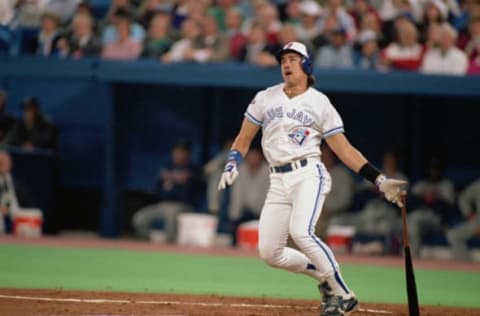
As there currently isn’t much on the horizon for baseball, we can look back at the history of the Blue Jays All-Time Developed Team.
In today’s ranking, I’ve taken a look at another All Blue Jays team, this one is about the top player at each position that the Blue Jays drafted, developed, and played a significant amount of time in Toronto.
The list doesn’t include players like Carlos Delgado who was signed as an international free agent, Manny Lee who was a rule 5 pick up or players like Jeff Kent who were drafted and developed but went on to have elite careers with other teams.
Catcher: Pat Borders
The 1982 MLB June Amateur draft could go down as the greatest draft the Toronto Blue Jays ever completed. They picked up three players in the draft that would play significant roles in the 1992 World Series. In the sixth round of the draft, Toronto selected Pat Borders out of Lake Wales High School in Florida.
If you want to talk about slowly developing a player, Pat Borders would be the prototype for this philosophy. Borders played 5 ½ years in the minors starting as a 19-year old in Rookie ball back in 1982. In 1988, after almost 500 minor league games he was brought up to back-up Blue Jays legend Ernie Whitt.
Everybody remembers J.P. Arencibia’s legendary first game, but Borders first game wasn’t too shabby either. Borders caught Mike Flanagan to his first win of the season, he threw out Willie Wilson trying to steal third base and went 3 for 5 with a triple and five RBI.
Borders would be Whitt’s back-up for the next two seasons before taking over as the Blue Jays’ number one catcher in 1990 and for the next five seasons.
In his first full season as the catcher, he threw out 43% of players attempting to steal on him, while allowing just six passed balls over 115 games. Every season as a Jays’ catcher, Borders threw out at least 31% would-be base stealers.
Borders is most known for his 1992 World Series heroics. During the Blue Jays first appearance in the World Series, Border went 9 for 20 (.450) with three doubles and a home run to take home the MVP honors. In the ALCS that year, he batted 7 for 22 (.318) with a home run and over 32 career playoff games, Borders had a .315 batting average and .753 OPS.
Borders would depart Toronto as a free agent prior to the 1995 season and bounce around the league playing for nine teams in 10 years, including a brief six game appearance back with the Blue Jays in 1999. Borders retired in 2005 last playing for the Seattle Mariners. He currently sits 42nd on the Blue Jays All-Time in home runs (fifth by catchers).
Honorable Mention: J.P. Arencibia and Danny Jansen

First Base: John Olerud
If Pat Borders was the prototype for slowly developing a player, John Olerud would be the exact opposite. In fact, you would be hard-pressed to find a player that had the same path to the majors as Olerud.
Olerud was drafted in 1986 out of high school in Washington, however, elected to go to Washington State University instead. In his first two years of NCAA baseball, Olerud absolutely dominated as both a pitcher and first baseman. In his second season in Washington, Olerud hit .464 with 23 home runs, while pitching to a record of 15-0 and a 2.49 ERA. He was named Baseball America College Player of the Year and an All-American at both positions he played.
In January 1989, Olerud suffered two major life-changing scares when he first was diagnosed with a subarachnoid hemorrhage, and then later in the month he was found to have a brain aneurysm which led to surgery. When Olerud returned to baseball in April he would wear a helmet on the field for the rest of his playing days.
In the June draft that year, Olerud made it known that a team would have to offer a large bonus for him to forgo his final season at Washington State. The Blue Jays drafted him in the third round and negotiated into August where he finally signed and by September 3rd that year he was stepping into the batter’s box against Major League Pitching without appearing in the minor leagues. Olerud went 3-8 in limited playing time, but was ineligible for the playoffs that year against the Oakland Athletics due to his late start.
In 1990, Olerud became an everyday player, but primarily at DH as 90 of his 108 games were in that position. The team felt comfortable enough going forward with Olerud as the everyday first basemen and it helped the team make their blockbuster trade, which meant moving out Fred McGriff and Tony Fernandez for Roberto Alomar and Joe Carter.
Olerud would play eight seasons in Toronto, he won the AL Batting title in 1993 with a .363 AVG as well as leading the league in doubles with 54. That season Olerud flirted with batting .400 and was still at the mark into early August.
Toronto and Olerud would part ways before the 1997 season when they traded him to the New York Mets for Robert Person. Olerud currently holds the fourth-best career batting average (.293) as a Toronto Blue Jay and is ninth in doubles.
Honorable Mention: Adam Lind and Rowdy Tellez
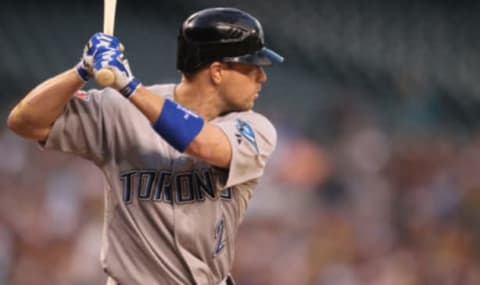
Second Base: Aaron Hill
The development for Aaron Hill would be a little faster tracked than a lot of players, but certainly not as fast as John Olerud. Going into the 2003 draft the Blue Jays had the 13th overall pick and did well in drafting Hill out of Louisiana University.
Hill had a good playing reputation as he won the 2001 Cape Cod League MVP and posted an NCAA career average of .335 with 23 home runs and 150 RBIs. After being drafted, Hill would play in “A” ball short season for 2003 and he impressed with a .324 average. In 2004, Hill jumped immediately up to New Hampshire where he played the full season and was able to hit quite well with 39 extra-base hits and 80 RBI. The following season he was promoted to AAA Syracuse but played just 38 games before being promoted to the Blue Jays and playing his first game on May 20.
When Hill made the jump to the major leagues he impressed immediately collecting multi-hit games in his first three games. After his first 11 games, Hill had two, three-hit games and four, two-hit games to have a .415 average with three doubles and two triples to go with 11 RBI. Hill finished up his rookie season in 2005 collecting 31 extra-base hits while batting .274, yet he did not get one vote for Rookie of the Year
Hill had a productive seven-year career with the Blue Jays, which included an All-Star appearance in 2009 when he also collected the Silver Slugger award for second basemen. That season, Hill batted .286 with 37 doubles, 36 home runs, and 108 RBI. Hill also finished 12th in the league in AL MVP voting.
The Blue Jays traded Hill, along with John McDonald in a bit of a tearful goodbye on August 23, 2011, to the Arizona Diamondbacks where Hill would go and play in his first postseason. Hill would leave Toronto as the All-Time doubles leader for second basemen in a Blue Jays uniform and had a career .265 average.
Honorable Mention: Orlando Hudson and Ryan Goins
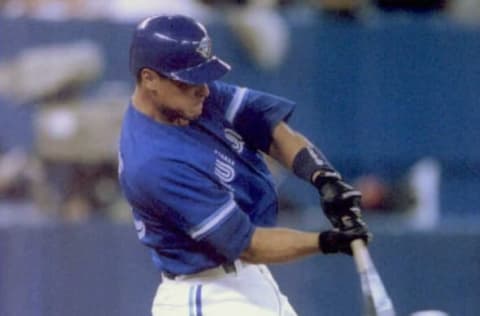
Third Base: Ed Sprague
When you look back at third basemen over the years, names that come to mind would be Kelly Gruber and Josh Donaldson, maybe Troy Glaus, Scott Rolen, or even Tony Batista. All of those players were acquired by the Blue Jays after the draft. A name that sometimes gets forgotten is the club’s starting third basemen for more than half a decade in the mid-1990s in Ed Sprague.
In 1988, Toronto used their first-round pick to select the big corner infielder out of Stanford University and while he spent a few years brewing in the minors, he jumped to AAA very quickly. After being drafted, Sprague would go and play for Team USA in the 1988 summer games instead of immediately going professional in the Blue Jays Organization. Sprague would help Team USA win the tournament, collecting a gold medal (although it was a demonstration sport that did not count to the countries totals).
The following season Sprague would split the season between Dunedin (A) and Syracuse (AAA) where he showed he would have some power but a high tenancy to strikeout. Sprague would finish with 38 extra-base hits and an almost 4:1 strikeout to walk ratio. Sprague would play his entire 1990 season in Syracuse where he cut down on strikeouts and added more power, as his strikeout to walk ratio dropped to almost 3:1, while almost doubling his home runs. The next two seasons, Sprague would split time between Toronto and Syracuse; and he would make a huge impact in the 1992 World Series
During the 1992 season, Sprague would be part of what Derek Bell called “The Trenches” which was a very good group of bench players in Toronto. During the 1992 World Series, Sprague would get just three plate appearances but he would make his at-bat in Game 2 count.
In the ninth inning, the Toronto Blue Jays were trailing 4-3 in the game and 1-0 in the series with Atlanta Braves closing pitcher Jeff Reardon on the mound and tying run Derek Bell on first base after a walk. Ed Sprague was brought into the game to pinch-hit for the pitcher and he would take a 1-0 Reardon pitch over the left-field fence for a home run and a late-game lead for the Blue Jays. Tom Henke would come on to close out the game and tie up the series, which the Blue Jays would end up winning their first WS Championship.
It appeared that the franchise had the confidence to go with Sprague as their starting third basemen as they moved on from longtime Blue Jay Kelly Gruber in favour of the younger Sprague. Sprague would play with the Blue Jays through 1998, which included being their starting third basemen for their World Series in 1993. Sprague would break out in 1996 with 36 home runs and 101 RBI.
During the 1998 season, the Blue Jays had Tony Fernandez, Ed Sprague, and Alex Gonzalez all on the line-up. They decided to move Fernandez to third base and traded Sprague to the Oakland Athletics for prospect Scott Rivette. Rivette would never get past AA while in Toronto, while Sprague would become an All-Star in 1999.
Sprague finished his Blue Jays career with 113 home runs and a .245 batting average. His home runs currently sit 17th all-time in Toronto.
Honorable Mention: None
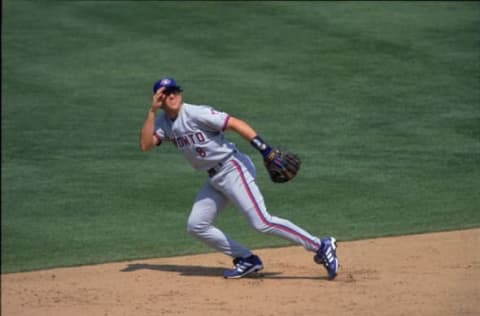
Shortstop: Alex Gonzalez
The franchise appears to have shifted from not drafting and developing shortstops to doing a nice job of that right now with Bo Bichette on the team and Jordan Groshans likely climbing the system soon. Until Bichette plays a few more seasons, Alex Gonzalez is the top drafted and developed Blue Jay at that position.
In 1991, the Blue Jays drafted the skinny kid out of Killian High School in Miami, Florida with their 13th round pick. Gonzalez had a more traditional development as he started his first season in Rookie ball and climbed one level each year until making his major league debut four days before his 21st birthday on April 4, 1994.
Through the minors, Gonzalez was showing himself to be a real star, as his defensive skills were elite and he was also bringing in offensive skills, as in his last three levels of baseball he had a .281 batting average and was finishing in double digits in home runs while playing against older and more seasoned ballplayers.
Gonzalez would become the Blue Jays starting shortstop in 1995 and would hold that position through 2001. Through his time with the Blue Jays, he was known as one of the better defensive shortstops in baseball and had his best fielding season in his last year in 2001 with a .987 fielding percentage.
After the 2001 season, Gonzalez was traded to the Chicago Cubs for relief pitcher Felix Heredia. Gonzalez currently sits 20th in games played by a Blue Jays and third among shortstops (Tony Fernandez and Alfredo Griffin). He is also first among all shortstops in franchise history in home runs.
Honorable Mention: Chris Woodward and Bo Bichette
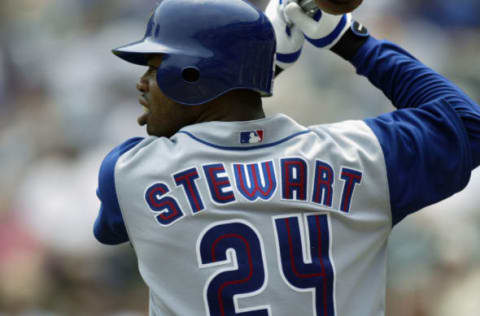
Left Field: Shannon Stewart
If I were to select the most underrated Blue Jay in team history it would be the team’s first-round pick in 1992 in Shannon Stewart. Stewart was drafted out of Miami Southridge High School as the 19th overall pick that draft.
After being drafted, Stewart played at every level over the course of six seasons and got better at each level he climbed. As Stewart advanced, the Blue Jays were really taking notice of their outfield prospect who had a ton of speed. In 1995, they tried to jump Stewart straight from AA to the major leagues as a September call-up, but after batting just .211 on 38 at-bats he would start the next season in AAA Syracuse.
The next season Stewart would get even better in AAA and again earn a September call-up, but again would struggle in limited time and would again start 1997 in AAA. The now soon to be 22-year old looked to be on a mission in Syracuse as he batted .346 with a .456 OBP over 58 games. In August that year, Stewart would be recalled for good. In the final 42 games of the year, he batted .286 with 10 stolen bases.
In his first full season in 1998, Stewart recorded a .279 batting average with 44 extra-base hits, an incredible 51 stolen bases, and a strikeout to walk ratio right around 1:1. The season would mark the only full season that Stewart would play in a Toronto uniform where he would bat under .300. In 2000, Stewart would have his best season finishing with 43 doubles, 5 triples, 21 home runs, and 20 stolen bases all while batting .319.
Stewart is second in franchise history in batting average (.298) trailing only Roberto Alomar while playing over 200 more games than the Hall of Famer. He is also fifth in stolen bases, seventh in hits and sixth in doubles.
In 2003, with the Blue Jays third in the division and nine games back of first, they traded Stewart to the Minnesota Twins for Bobby Kielty, who they flipped that offseason for Ted Lilly. In that final season in Toronto that he split with the Twins, he finished fourth in the AL MVP voting behind winner Alex Rodriguez, along with Jorge Posada and teammate Carlos Delgado.
Honorable Mention: Reed Johnson
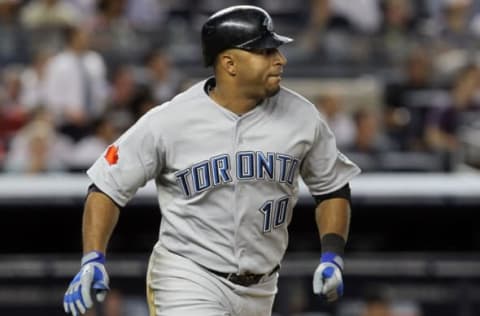
Center Field: Vernon Wells
Very few times in franchise history have the Toronto Blue Jays had a top-five pick in the MLB Amateur draft. In 1997, that is the exact spot Toronto was drafting and they did not miss selecting power-hitting centre fielder Vernon Wells.
Like many drafts, the Blue Jays got a top prospect straight out of High School as Wells was an 18-year-old coming out of Arlington, Texas. After being drafted in June 1997, Wells played in Single-A Short Season in St. Catherines and hit quite well, as in 66 games he had 31 extra-base hits to a .307 average.
The following year he moved up to play in Single-A, but 1999 was his breakout season. Wells started out in Dunedin (A+), moved to Knoxville (AA), then Syracuse (AAA) before being a late-season call-up to the majors and played 24 games for Toronto. Wells held his own batting .261, however, struck out 18 times to four walks.
Wells would spend all of 2000 in Syracuse with the exception of a pair of at-bats as a September call-up. In 2001, Wells would get an opportunity in May where he got into eight games, however, he was sent back to AAA for the season until he was called up for good in late August. Wells would get into 30 games hitting nine extra-base hits and collecting five stolen bases to a .313 batting average.
Wells spent nine full seasons as the Blue Jays centre fielder and a lot of the fans view of Wells is tainted by a contract that he signed. After the 2006 season in which Vernon Wells was coming off his third consecutive Gold Glove Award, being named an All-Star, having previously won the Silver Slugger Award for centre field and averaged 37 doubles, 28 home runs and 97 RBI over his past five seasons, he signed a massive 7-year, $126 million deal.
Over his next three seasons, Wells hit just 16, 20, and 15 home runs, never collecting more than 80 RBI. Fans started to turn on one of the top hitting players the franchise ever developed. In his final season in 2010, Wells was named an All-Star for the first time since signing the contract. He hit .273 with 31 home runs and 88 RBI that season, but new GM Alex Athonpolous took the opportunity to unload the contract and traded Wells to the Los Angeles Angels without retaining any money.
Wells would not be able to regain his early career success and retired after 2013 when his contract ran out. Wells is currently fourth in franchise history in home runs with 223 and second in RBI and doubles trailing Carlos Delgado.
Honorable Mention: Lloyd Moseby and Kevin Pillar
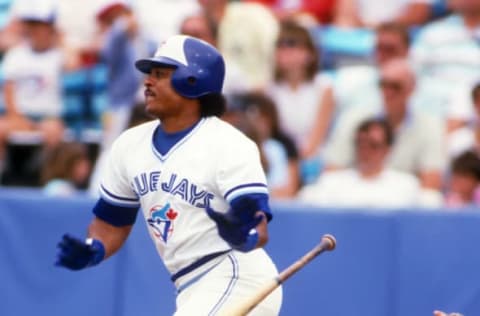
Right Field: Jesse Barfield
When writing this piece, Right Field stood out as the toughest choice between Shawn Green and Jesse Barfield, but I went with the older guy in Barfield. In 1977, the Blue Jays were in their first-ever season in the league and as such, it was their first draft. In the ninth round, 233rd overall they selected high schooler Jesse Barfield out of Central High School in Joliet, Illinois.
Barfield spent five seasons developing through the minors and showed some power in his last couple years playing in AA Knoxville, but didn’t light it up. It wasn’t until he made the majors that he started to show his real talent. After being a September call-up in 1981, he became a full-time player in 1982.
In his rookie season, Barfield quickly got a reputation as having an electric arm as he threw out 15 runners and followed that up with 17 in 1983. Because of the reputation he built, teams just stopped risking trying to stretch an extra base. At the plate, Barfield hit 18 home runs and had a .246 batting average to help him finish eighth in Rookie of the Year voting.
Barfield became an elite outfielder and had a career season in 1986 that saw him hit 77 extra-base hits which included 40 home runs and 108 RBI while batting .289. That season Barfield was selected to the All-Star Game, was awarded the Gold Glove and Silver Slugger award, while finishing fifth in AL MVP voting.
Barfield would play nine seasons in Toronto, winning another Gold Glove and hitting 179 home runs. In 1989, with the team looking for their second AL pennant and requiring some pitching, the Blue Jays traded Barfield to the New York Yankees for Al Leiter. Barfield currently sits seventh all-time in home runs by a Blue Jay.
Honorable Mention: Shawn Green and Alex Rios
Stieb's Improbable Comeback. dark. Next
Stay tuned for my next article that will show you the top five starting pitchers that were drafted and developed by the Blue Jays.